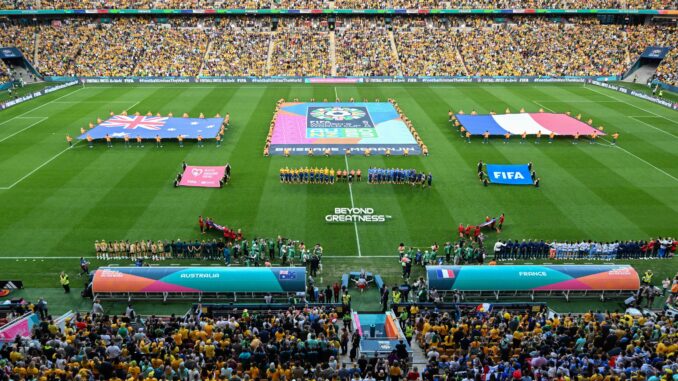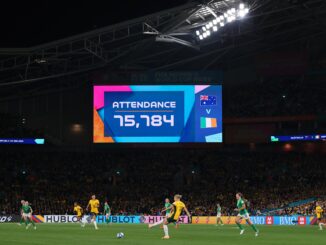

AFC president Shaikh Salman has been conspicuous by his absence over the past month, invisible at a World Cup hosted in the Confederation of which he is the president, but surely even he wasn’t able to avoid the unprecedented frenzy that gripped Australia during the Women’s World Cup.
After China hosted the tournament in 2007, this was just the second time that Asia has hosted the global showpiece, with a record six AFC nations participating across Australia and New Zealand.
While there are questions over the success or otherwise of Asian teams on the pitch, something we will get into another day, there can be no doubting the success of the tournament off-the-pitch.
Its success has elevated the Women’s World Cup to new and unprecedented levels. Ticket sales, attendances and TV ratings have been smashed, setting a new benchmark for the tournament moving forward.
Just shy of two million people attended the tournament across both Australia and New Zealand, at an average of almost 31,000, smashing the previous record. The sight of packed stadiums, even for perceived less glamorous fixtures, should be all the proof AFC needs as it considers its options for the 2026 AFC Women’s Asian Cup.
With Saudi Arabia and Uzbekistan the two other confirmed bidders, Australia faces competition from two nations very much in the ‘developing’ stage of their women’s football journey.
That in some cases makes their respective bids more compelling, as AFC can point to the fact that they are looking to push and develop women’s football in new markets, and in the case of Saudi Arabia, act as a pioneer and catalyst for change for the entire Gulf region which still faces significant cultural hurdles when it comes to the development of the women’s game.
While there is cynicism surrounding Saudi Arabia’s bid, they have over the last few years proven their bonafides in women’s football.
From the launching of the first ever senior national team, which is now officially ranked by FIFA, through to the development of under-age teams, Futsal teams and competitions and, most significantly, a two-tier national domestic league, the investment has been unprecedented in the Middle East.
The fledgling domestic league, which just this week announced prize money of over $500,000 (USD), has already attracted names like Morocco’s Ibtissam Jraidi, who created history at the Women’s World Cup by becoming the first Arab player to score at the tournament, and Sweden’s Nor Mustafa, who as recently as 2021 played for West Ham in the WSL.
Respected American coach, Kelly Lindsey, who formerly took charge of Afghanistan, has also been hired by Al Ittihad as their new manager as the league looks for outside assistance to grow its stature.
Despite all of that, however, there is a prevailing view, held by some even within the Kingdom, that 2026 is simply too soon on their journey, and while the country will be ready from an infrastructure point of view, the team would not and would risk being uncompetitive in their first major international tournament.
While Uzbekistan are more advanced in their journey, ranked ninth in Asia, just behind the Philippines, they cannot come close to competing with Australia and the scenes witnessed across the country in the past month.
It’s true that an Asian Cup is a completely different kettle of fish to a World Cup, but the unleashing of the passion for women’s football witnessed over the past month, particularly among Australia’s large and vibrant migrant communities, should give a high degree of confidence that similar scenes can be replicated, even if on a smaller scale.
You only need to look back at the stunning success of the men’s Asian Cup in 2015 for evidence of how Australians will get behind a tournament such as this.
With AFC needing to turbocharge its investment and development of women’s football in order to keep pace with the rapid growth witnessed in Europe and North America in particular, it needs its showpiece tournament to be just that – a showpiece tournament.
As compelling as the arguments are to take the tournament to developing markets, the AFC has done that with the past two tournaments in Jordan and India.
Embed from Getty ImagesWhile both were historic events in their own right, they did little to showcase women’s football in Asia as a truly elite product, with just over 31,000 – the average attendance at this FIFA Women’s World Cup – attending the entire tournament in Jordan for an average of just over 1800 per game.
India’s hosting in 2022, meanwhile, was crippled by the COVID pandemic, making it a shell of what it could’ve been with no fans allowed to attend.
Football, as a product, is infinitely better when the stands are full and the players can feed off the energy of the crowd.
The next tournament, therefore, needs to show women’s football in the best possible light. It needs to show it how Australia has shown it for the past month.
As the rest of the world develops at lightning speed, Asia needs to show it is keeping pace. It needs packed stadiums, it needs fervent atmospheres and it needs a buzz that has been largely devoid in previous editions.
It’s also worth pointing out that the strength of the women’s game in Asia is very much in the east.
All six who played at this World Cup are from this side of the continent. Staging a tournament in a timezone that is friendly for those nations should also guarantee more eyeballs on the tournament, as opposed to Japan, China or Australia playing games in the middle of the night.
When you consider 54 million people in China watched their clash with England, and that the Matildas broke every TV ratings record in Australia, then a tournament in the same timezone has a lot of appeal.
The afterglow of this Women’s World Cup will last years. Perhaps even up until 2026. With AFC reportedly due to announce the host within the next few months, perhaps even as early as next month, riding on the coattails of this tournament and trying to capture some of that afterglow would not only be a very smart move, but all but guarantee the afterglow does continue on until 2026.
The excitement for another major tournament in which the Matildas are a genuine chance to win silverware would be palpable.
Shaikh Salman may not have been here to witness it for himself, and it may not be his decision alone, but after this Women’s World Cup the decision is an easy one.
Australia 2026. Bring it on.
Listen to The Asian Game Podcast LIVE from the FIFA Women’s World Cup




